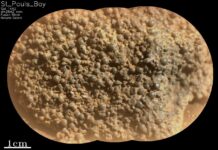In an impressive display of progress and innovation, NASA has reached a new milestone in its Artemis program, a series of missions aimed at exploring the Moon and beyond. On December 11, 2024, a significant development took place at NASA’s Kennedy Space Center in Florida. Here, the towering 212-foot Space Launch System (SLS) core stage was carefully maneuvered and lowered into High Bay 2 within the Vehicle Assembly Building. This strategic relocation allows NASA and Boeing technicians complete 360-degree access to the core stage, facilitating thorough inspection and maintenance both inside and out.
The Artemis program, named after the Greek goddess of the Moon, represents NASA’s ambitious return to lunar exploration. At the heart of this program is the Artemis II test flight, which is scheduled for launch in 2026. This mission marks a critical step forward for NASA, as it will be the first Artemis mission to carry a crew. The astronauts selected for this groundbreaking journey include NASA’s Victor Glover, Christina Koch, and Reid Wiseman, along with Canadian Space Agency astronaut Jeremy Hansen. Together, they will embark on a remarkable 10-day expedition that will take them around the Moon and safely back to Earth.
The significance of Artemis II cannot be overstated. It represents a pivotal moment not just for NASA but for space exploration as a whole. This mission is poised to set the stage for future lunar exploration, laying the groundwork for sustainable human presence on the Moon. By successfully executing this mission, NASA aims to demonstrate the capabilities of the SLS and Orion spacecraft, proving their reliability and readiness for more complex missions in the future.
The SLS, or Space Launch System, is an advanced, heavy-lift launch vehicle designed to propel astronauts farther into space than ever before. It serves as the backbone of NASA’s deep space exploration efforts, providing the necessary power and flexibility to support a wide range of missions. The core stage of the SLS is a marvel of engineering, featuring large tanks that store liquid hydrogen and liquid oxygen, which are combined to generate the immense thrust needed to escape Earth’s gravitational pull.
High Bay 2 at the Vehicle Assembly Building is a critical facility that allows technicians to work on the SLS with unparalleled access. This facility is equipped with state-of-the-art technology to support the assembly and integration of large space vehicles. By moving the core stage to High Bay 2, NASA ensures that every component of the SLS can be meticulously examined and optimized for peak performance.
The crew of Artemis II is composed of seasoned astronauts, each bringing a wealth of experience and expertise to the mission. Victor Glover, a NASA astronaut, has previously served as a pilot on the SpaceX Crew-1 mission to the International Space Station. Christina Koch holds the record for the longest single spaceflight by a woman, having spent 328 days aboard the ISS. Reid Wiseman, a NASA veteran, has also completed a mission on the ISS, where he conducted numerous experiments and spacewalks. Jeremy Hansen, representing the Canadian Space Agency, is set to make history as the first Canadian to travel beyond low Earth orbit.
For those interested in the technical aspects of space travel, the Artemis II mission provides a fascinating glimpse into the future of human exploration. The mission will test new technologies and systems, ensuring they meet the rigorous demands of deep space travel. This includes evaluating life support systems, navigation and communication technologies, and the overall performance of the spacecraft in the harsh environment of space.
The Artemis program also carries significant implications for international collaboration in space exploration. By including a Canadian astronaut in the mission, NASA underscores the importance of partnerships with other space agencies. This collaboration not only enhances the capabilities of the mission but also fosters a sense of unity and shared purpose among nations engaged in the exploration of space.
As the world looks forward to the launch of Artemis II, there is a palpable sense of excitement and anticipation. The mission promises to inspire a new generation of scientists, engineers, and space enthusiasts, reigniting the spirit of exploration that defined the Apollo era. By venturing beyond the confines of Earth, NASA and its partners are paving the way for a future where humans live and work on the Moon, and eventually, on Mars.
In conclusion, the relocation of the SLS core stage to High Bay 2 marks a critical step in the preparation for the Artemis II mission. This development not only signifies progress in the Artemis program but also highlights NASA’s commitment to advancing human space exploration. As the launch date approaches, the world will be watching closely, eager to witness the next chapter in humanity’s journey to the stars. For more information on the Artemis II mission, you can visit NASA’s official website.
Image credit: NASA/Kim Shiflett
For more Information, Refer to this article.


































